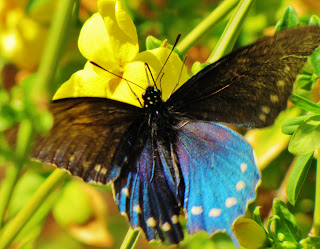 |
| Pipevine Swallowtail Battus philenor |
Again, note how camouflage plays an important role in our desert environment. Urosaurus ornatus or
the Tree Lizard
This is a butterfly of riparian corridors in the Sonoran Desert where its required food plants, willows and cottonwoods, are found. There are many butterflies that closely resemble the Pipevine Swallowtail -- Battus philenor. This butterfly was a hard one to identify, and thanks to Randy Emmett, I have the correct label.
This butterfly was floating around with several of its mates near Carolina Jasmine Vines. I labeled it first as the Pipevine Swallowtail, but then doubted myself because it's a rare find.
Again, this is another tricky critter to snap on camera. My frustration will come at times when I have the shot and families come along with screaming children.......many times I have to get off the main trail to get those pics and that's okay. However nature happens when it happens.
This arboreal lizard most commonly lives in riparian zones in mesquite, alder and cottonwood, but it also is found on non-riparian oak, pine, and juniper. The tree lizard is also found on some non-native trees such as eucalyptus and tamarisk, and in some treeless areas; it is often very abundant on granite boulder piles. Color and pattern serve it well in avoiding detection by would-be predators.
 |
| The bees were out and about with Spring in the air. |
There's your creature feature fun. 2 more posts coming up on the Boyce Thompson Arboretum. Until tomorrow....
 Labels:
Arizona Red Spotted Purple butterfly,
Battus philenor,
Boyce Thompson Arboretum,
Pipeline Swallowtail,
tree lizard,
Urosaurus ornatus
Labels:
Arizona Red Spotted Purple butterfly,
Battus philenor,
Boyce Thompson Arboretum,
Pipeline Swallowtail,
tree lizard,
Urosaurus ornatus






Posting Komentar